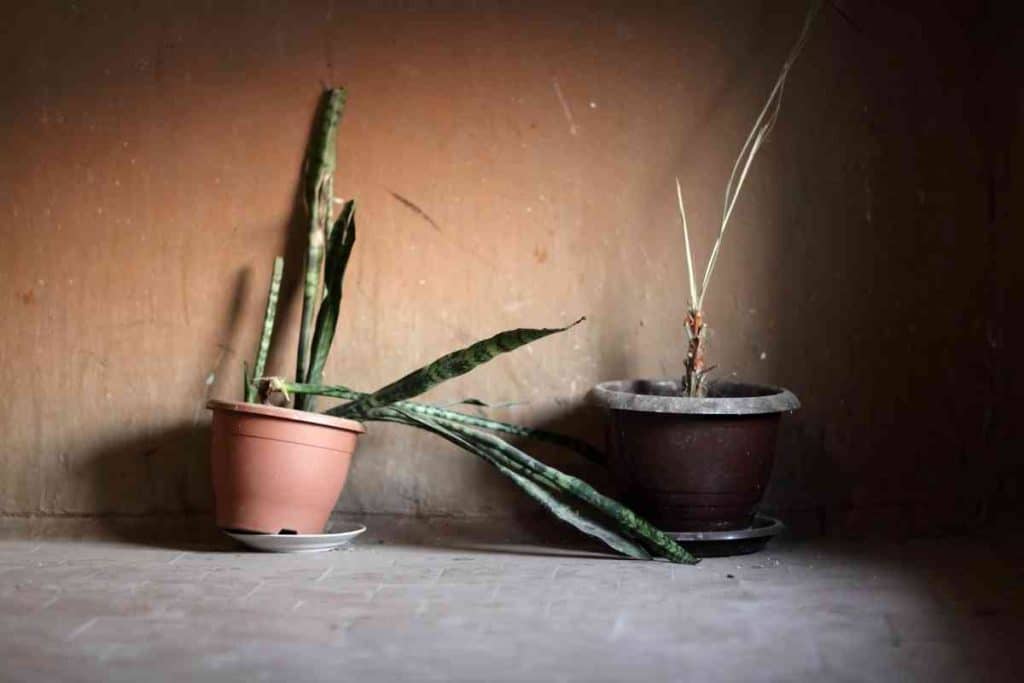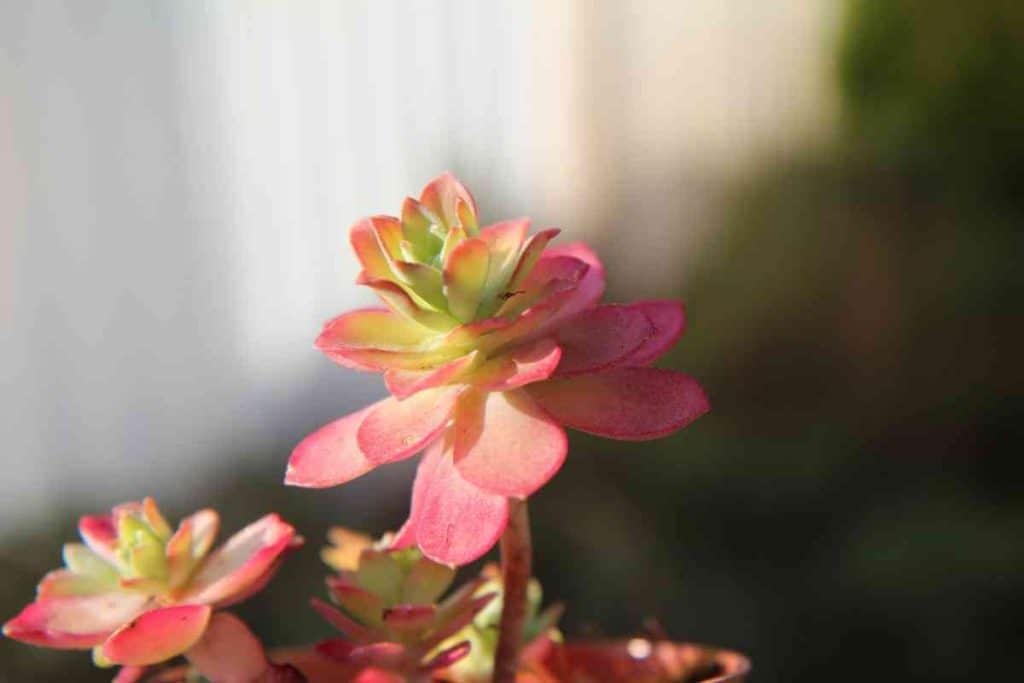Do you like the appearance of succulents but find it difficult to keep them alive? Do you have a large garden (or not), but succulents don't seem to be your thing? It appears that you require Succulents 101! But why is my succulent dying, you wonder?
There are many factors that can contribute to the death of succulents, and by making some simple modifications, you can achieve some incredible results. It could be because the plant is getting too much water, too little water, too much sunlight, or too little sunlight.
In this article, you're going to learn why your succulent is dying, what a dying succulent look like, how to save a dying succulent, and everything other thing you need to know to keep your succulent alive and healthy.
Let's get started!
Table of Contents
What Does a Dying Succulent Look Like?
It's presumed to be simple to care for a succulent. However, there are a few points to note in order to keep it fresh and healthy. How do you know whether your succulent is flourishing or dropping dead? What does a dying succulent look like?
In summary, common signs that a succulent is dropping dead include:
- The presence of brown, mushy leaves indicates that the roots are rotting
- Freckled, yellow leaves imply the spread of rot or infection
- The presence of wrinkled, low–moisture leaves indicates that the roots are drying out
- Brown roots implied rot or infection
These are some warning signs that your succulent is not doing well.
Do not water the plant again right away. Before watering, keep an eye on it for several days to a week.
Note that it is too late to repot if the rot has expanded to the culm or foliage.
Why is My Succulent Dying?

Having looked at what a dying succulent often look like, what now talk about why your succulent is dying!
1. Drooping Leaves on a Succulent
Overwatering succulents is the most common cause of drooping leaves. This problem is treated similarly to root rot: snip the bottom, repot, and then re-water when fully prepared.
When repotting the plant, take particular precautions not to damage the succulent. Despite being resilient, succulent roots are fragile and do not always recover from trauma.
2. Succulent that is tall, thin, and stretched
Lankiness indicates that the succulent is not receiving enough sunlight. It may indicate a serious dilemma.
The stretched-out areas will never be repaired. The best way to proceed is to nourish the new shoots for improved health.
Snip the leaves at the plant's bottom and take very good care of them. If this doesn't work, it's time to start looking for a new succulent.
3. Red Succulent Leaves Under Stress
Red leaves may imply succulent strain; succulents, like people, get stressed when exposed to less or more light or too much or too little water. Stress does not automatically imply that the plant will die; rather, it indicates that it may require additional tender loving care.
Some growers will purposefully stress their succulents to enhance the look of the red leaves. Only those with a "green thumb" and competence should purposefully stress a succulent.
4. Succulent has been harmed by trauma or bugs
Succulents may be damaged if the pot is nudged over or if they become infested with bugs. Small brown spots on the leaf surface imply that the plant has been traumatized. Your succulent can live if you take extra care and patience.
5. The Succulent Was Overexposed To The Sun
A succulent, like us humans, can get sunburned if it is overexposed to UV rays. If the plant receives too much sunlight, the leaves will transform to dark brown.
There is no sunblock for succulents like humans; however, keeping the plant in an appropriate location with the appropriate amount of sun will benefit the plant.
6. Wilting and dried-out leaves
To begin with, remember that fading leaves are a normal byproduct of every plant's life — and succulents are the same everywhere. Dried-out leaves do not always imply that your succulent is dropping dead or that you are doing something incorrectly.
If the bottom leaves of your succulent have run dry, it is still actually healthier, but they may have to be sprayed more regularly. As your plant ages, it produces new foliage while discarding the old ones.
So, if you notice a few dry, crumbly leaves at the bottom of the crop only at the bottom–don't be alarmed. The development is completely normal!
On the other side, if any of your succulents' foliage is running dry, this is an indication that it needs to be irrigated more frequently.
If the dry leaves become unaesthetic, pull them softly apart from the plant's bottom and discard them. Leave your plant potted when removing the leaves to avoid disturbing the root systems. Pry only the leaves that fall off conveniently or are completely dead.
7. Overwatering
While fallen leaves at the bottom of your succulent are completely healthy, dying leaves on the tops of new shoots indicate a dilemma, usually overwatering or underwatering. It's worth noting that succulents can also be harmed by soil.
Overwatering is likely to have caused your plant's leaves to turn yellow and feel wet or squishy to the hands.
Overwatering causes leaves to drop off with just a minor bump, an early indicator of overwatering. If you realize your succulent has a black culm or mush patches on the shaft or leaves, the over-watering is pronounced, and it may be tricky to save it.
Overwatering affects a few succulents more than others. Echeverias appear to be among the most delicate. These lovely rosettes will rot in 2 or 3 days if exposed to too much moisture.
The easiest way to avoid over-watering is to wait until the soil is totally dry before misting again. Most succulents can conveniently go three days (and perhaps even a week or more) without moisture, as stated in numerous other articles–so when in doubt, linger before irrigation.
Begin by reducing your irrigation schedule as soon as you notice the clinical signs of over-watering on a few of your plants. You may also have to change to an improved soil mix and use a pot with a drainage groove.
If your succulent has a black shaft or flaws, you'll need to perform minor surgery to save it.
While the initial plant is unlikely to continue, it's worth seeing! Consider leaving the bottom section alone and don't water till the soil is completely dry. If you're blessed, a few days of drying time will allow the plant to recoup from the over-watering, and it may even begin to sprout new shoots.
You don't want to take the chance of causing problems for the other succulents if the rotting succulent was in a layout with them. It is suggested that relocating and expelling the decomposing succulent in this particular instance will help.
8. Underwatering
While overwatering has been the most frequent problem with succulents, many succulents are also susceptible to underwatering.
If your plant's new leaves begin to curl and become dry and crispy, it's time to offer your succulents a drink.
Your succulent will look fresh and new in a week or two if you hydrate it more frequently.
It's much easier to resurrect an under-watered succulent than an over-watered one. When yours are just beginning to blot, the succulents should perk up after one or multiple watering periods. If they've completely turned black, they're presumably too far past to retrieve.
To help them rebuild from underwatering as quickly as possible, soak the soil thoroughly when you water.
You can, however, try water rehab if you're feeling daring and perhaps a little anxious. However, this is ONLY for succulents that are under-watered.
Recognizing the clinical symptoms of watering issues will allow you to save your succulent before it becomes too late.
How to Save a Dying Succulent (Key Pointers)

Overwatering, underwatering, too much sun, insufficient sun, and trauma can all be complicated for succulent care.
Because these conceivably abundant plants cannot communicate when sick, it is essential to keep an eye on your succulent for warning signs. Here are some tips for caring for a plant and making it thrive.
Ensure that the plant receives plenty of sunlight.
A well-established succulent requires up to six hours of direct sunlight per day. If your succulent is brand new, you will need to gradually attune it to the sun. Position the plant at the front of the window but behind a boundary such as a light veil or something that does not allow direct sun.
That said, below is how to save a dying succulent plant:
1. Turn the pot around
Succulents frequently grow and prosper in sunlight; spinning the pot lets the plant absorb those rays. If your succulent is swinging to one side, spin the pot and observe it stand upright.
2. Watering During Season
Succulent development will halt during the winter or fall. The weather in the spring and summer months promotes growth and reinvigoration. During these seasons, more water is required because the plant expends more power to regenerate.
Put your fingers about an inch to an inch and a quarter into the soil to ensure that your plant is not under or overwatered.
To ensure that your plant is not under or over-watered, stick your finger about an inch to an inch and a quarter into the soil. If the soil is dry, your plant will require water. Recall not to overwater the plant; as noted previously, more water less frequently is the cornerstone.
3. Impose water to the soil effectively
A sufficient dose is to soak the soil until water leaves the holes in the bottom. According to some growers, using an ice cube or two and enabling the water to start melting into the soil is preferred.
The plant will consume more water to reach its roots during the spring and summer. Dousing the plant during its summer months is ideal.
4. Succulent cleaning
Nobody likes to be untidy or dirty, including your prized plant! Include your succulent when dusting your home. Use no dusting polish or biological solvents. Instead, dampen a microfibre cloth and use it to polish the plant's foliage. Use a soft-tipped brush doused in water to reach those tough areas.
5. Make use of a pot with adequate drainage
Plant rot is caused by doused soil; use a pot with at least another draining groove and a saucer beneath. Two holes are preferable. Terra Cotta pots are an excellent choice for beginning succulent gardeners.
6. Use the right soil
Using dirt from your yard or standard peat-based soil results in a dissatisfied plant.
Succulents entail their soil, the same soil as Cactus and other drought-tolerant plants. Grow your succulent in soil containing sand, pumice, or perlite. If you want to use standard potting soil, add some sand, pumice, or perlite.
7. Get rid of bugs and possible trauma
Gnats enjoy obstructing succulents. These irritating insects are simple to eradicate.
Spray 70% alcohol on the leaves to get rid of the gnats.
If your succulent is bug-infested, keep a safe distance from your other seedlings. Mealybugs can be killed with an alcohol sprinkler if too much water.
Aside from bugs, ensure your pot is not easy to knock over. An accident of this nature can cause trauma to the plant and lead to irreparable harm.
8. Fertilization in the summer
Supplementing your succulent during the spring and summer months aids the plant's recovery. Overfertilization of the plant can end up causing it to become vulnerable.
How to Choose the Best Soil and Fertilizer for Succulents

While different from basic garden soil, succulent soil and fertilizer does not have to be costly. Here are a few soil and fertilizer recommendations.
Use a Gradual Fertilizer
Fertilizers cost about $6 per container on average. Make sure to select a fertilizer appropriate for your plant's location, whether indoors or outdoors.
Choose a gradual fertilizer as well. A slow-release fertilizer will not over-fertilize the plant, and the plant's food will result in additional sustained growth.
Fertilized Soils Are an Excellent Option
Fertilizer-infused soils are also excellent for getting the most bang for your buck. There's no need to buy multiple products; the succulent soil and fertilizer mixture makes plant care simple and cost-effective.
See Also: Can You Use Regular Potting Soil For Succulents?
Frequently Asked Questions
What is the best way to save a fading succulent?
In most instances, saving dying succulents is a simple process. After one "event" that caused their weakness, give them good care. If all else fails, save a good leaf or stem remnant, let it callus, and plant in a succulent mix.
What causes the death of my indoor succulents?
Improperly watering indoor succulents is one of the swiftest methods of killing them. Succulents' water can be stored in their thick, large leaves. They'll depend heavily on these freshwater supplies to stay alive in arid conditions, but they'll still need to be watered regularly to thrive. Too much water, on the other hand, is lethal to these plants.
How can I tell if my succulent has been overwatered?
The first indication of overwatering succulent is darkening and a shift in the shape of the leaves. The leaves will become translucent, gentle, and doughy, and, unlike those under-watered, they will be dropping rather than regained by the plant.
Can succulents die due to a lack of sunlight?
Etiolation is most likely afflicting your plant. You're probably aware of why most succulents are native to desert regions and require a lot of sunlight. Growing plants outdoors may not be possible if you live in a location that receives little sunlight.
Do succulents bloom when they are stressed?
Remember that succulents do not require much hydration, even to grow. A flower on a pressured succulent may amaze you if it is appropriately positioned – occasionally, it's really about location, location, location.
What causes succulents to turn red?
Some succulent plants develop reddish tips on their leaves when exposed to direct sunlight or extreme heat. To safeguard itself from sunburn, the plant produces a red pigment (carotenoids) on its vegetation in response to the intense temperatures.
What causes the death of a succulent?
Urban flooding of a succulent's roots is probably the cause – essentially, the soil stays too wet for too much, and the roots keep on drinking since they don't know right from wrong. Urban flooding causes the root to decay first, and then the rot spreads to the plant.
Conclusion
When your succulent isn't doing well, it will let you know. Pay particular attention to the leaves' presentation and the soil's moisture level. Many problems can be resolved before your plant dies. It may be too late once the clinical signs have worsened.
Whenever anyone discusses that their succulent has issues, it is crucial to inquire when they last hydrated it. Watering can be difficult to keep track of; however, it will undoubtedly assist you in keeping your succulents alive for a longer period.
When you can use anything to document your watering schedules (pen and paper, worksheet, phone notes), remember to always check in or set reminders if you are using digital means.




